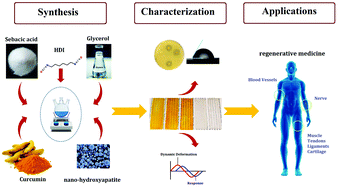Development of physical, mechanical, antibacterial and cell growth properties of poly(glycerol sebacate urethane) (PGSU) with helping of curcumin and hydroxyapatite nanoparticles†
Abstract
Biocompatible and antimicrobial elastomers with controlled hydrophilicity and degradation rate, as well as appropriate stiffness and elasticity, are interesting for biomedical applications, such as regenerative medicine and tissue engineering. Nevertheless, most of the tissue-engineered scaffolds do not possess a combination of the aforementioned properties. In this study, we prepare a library of poly(glycerol sebacate urethane)s (PGSU) containing different concentrations of hydroxyapatite nanoparticles (nHA) and curcumin. Poly(glycerol sebacate) prepolymers were crosslinked by hexamethylene diisocyanate, and the resulting elastomers were investigated by FTIR spectroscopy. The bioelastomers had an elastic modulus and ultimate tensile strength within a range of 1.9–4.1 MPa and 1.6–2 MPa, respectively. PGSU showed a water contact angle of 85.0 ± 2.2°. The hydrophilicity significantly improved by adding nHA, and the water contact angle was reduced to 71.8± 1.1°. It was found from the hydrolytic degradation study that while nHA accelerated the degradation rate, the hybrid nHA/curcumin compound noticeably reduced it and then increased the physiological stability of the PGSU matrix. Furthermore, the scaffolds loaded with curcumin exhibited significant antimicrobial activity against both Gram-negative (P. aeruginosa) and Gram-positive (S. aureus) bacteria. The in vitro biocompatibility tests showed significant cell attachment, proliferation, and viability of mouse fibroblast L929 cells. Our findings indicated that the addition of curcumin and nHA into PGSU could impart new features to the PGSU matrix and introduce the PGSU-based elastomers as a promising candidate for a range of tissue engineering applications, specifically hard tissues.

- This article is part of the themed collection: Polymer Chemistry Lectureship Winners


 Please wait while we load your content...
Please wait while we load your content...